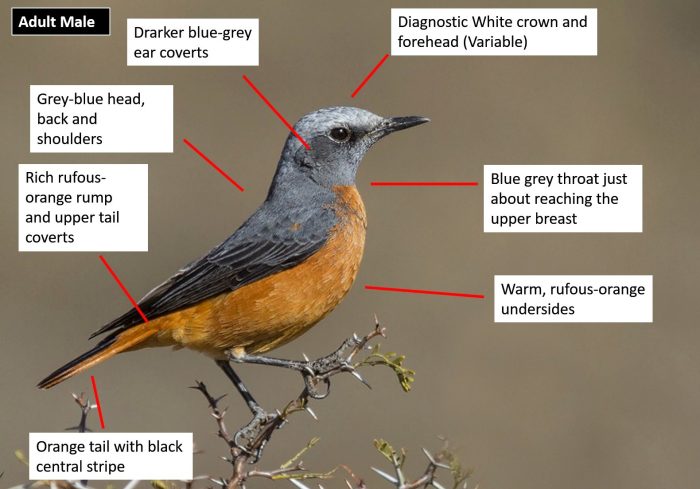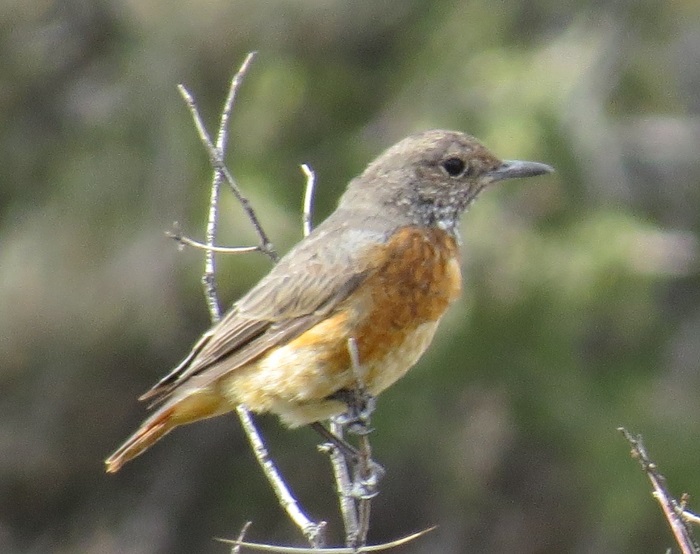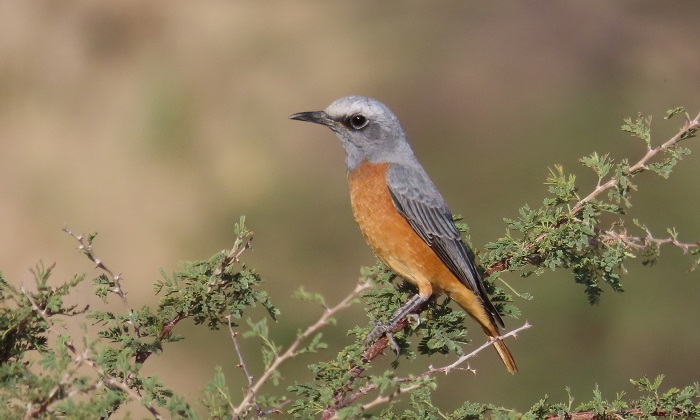Cover image of Short-toed Rock-thrush by PR Kleiman – Near Riemvasmaak, Northern Cape – BirdPix No. 245207
Identification
The Short-toed Rock-thrush is a small and attractive species. They are sexually dimorphic in that the male is a striking, colourful bird while the female is comparatively drab.

Mountain Zebra National Park, Eastern Cape
Photo by Desire Darling
Males have blue-grey upperparts including the head, mantle, back and shoulders. The underparts are rich rufous-orange. There are two subspecies, Monticola brevipes brevipes and Monticola brevipes pretoriae. The pretoriae subspecies lacks the diagnostic white crown of the nominate race.
Females of both races have rufous underparts, (duller than the male) that grade to paler buff on the lower belly and vent. The chest area sometimes shows dark and light mottling. The females head and upperparts are plain greyish brown and the throat is white with dark brown speckling.

Karoo National Park, Western Cape
Photo by J. Terblanche
Juveniles resemble females but show buff-tipped feathers on the upperparts.
Adult males are easily distinguished from other rock-thrush species by the white crown, however, the grey-crowned pretoriae race can easily be mistaken for the Sentinel Rock-thrush but is smaller, with shorter legs and richer, deeper rufous underparts.
Status and Distribution
Locally fairly common to common. The Short-toed Rock-thrush is near-endemic to Southern Africa, extending only marginally into south-western Angola. Its range is largely confined to the arid western and central parts of the subcontinent. Its distribution is unusual in that it doesn’t conform to any major biomes. There are three focal or core areas within its range, the Namibian escarpment, north-eastern parts of the Northern Cape and adjoining areas in the Free State, as well as scattered localities in western Gauteng, and adjoining regions of Limpopo and North-West Province, as well as parts of eastern Botswana.

Details for map interpretation can be found here.
There is no evidence regarding changes to its distribution and the Short-toed Rock-thrush is not threatened.
Habitat
Inhabits rocky outcrops, escarpments, inselbergs and river valleys with scattered bushes and trees, usually in areas of relatively low rainfall. They also frequent the edges of towns and villages when close to suitable habitat. In winter, more extensively in flat country and around human habitation.

Near Carnarvon, Northern Cape
Photo by Ryan Tippett
Behaviour

Dealesville district, Free State
Photo by Rick Nuttall
The Short-toed Rock-thrush is usually solitary or in pairs.
It is both a resident and seasonal migrant. It shows definite seasonal movements and migrates altitudinally, dispersing widely when at lower altitudes in winter. This is perhaps forced by scarce food resources in arid areas, particularly during winter.
Forages on the ground and hops about on rocks and regularly perches in trees or on buildings. Sometimes drops onto prey from a perch. The diet consists mainly of insects like grasshoppers, caterpillars, beetles, termites and ants. It is also recorded to feed on millipedes and scorpions as well as some fruit and seeds.
It is shy and wary in its natural habitat but can become tame and confiding around human habitation.

Rooiklip Farm, Namibia
Photo by Johan and Estelle van Rooyen
Breeds from August to March (spring to late summer), although few published records are available. The nest is a bulky cup-like structure made from plant stems and leaves. The nest is placed on the ground but is usually well hidden under a rock slab, behind grass or among tree roots. The nest is built entirely by the female. 1 to 4 unmarked blue eggs are laid per clutch and all incubation duties are performed by the female. The incubation period lasts for 13 to 14 days. Nestlings take 15 to 17 days to fledge, during which time they are fed by both sexes.

Near Campbell, Northern Cape
Photo by Les Underhill
Further Resources
Species text adapted from the first Southern African Bird Atlas Project (SABAP1), 1997.
The use of photographs by Brendon White, Desire Darling, J. Terblanche, Johan and Estelle van Rooyen, Les Underhill and Rick Nuttall is acknowledged.
Virtual Museum (BirdPix > Search VM > By Scientific or Common Name).
Other common names: Korttoonkliplyster (Afrikaans); Monticole à doigts courts (French); Kurzzehenrötel (German); Kortteen-rotslijster (Dutch); Melro-das-rochas-de-dedos-curtos (Portuguese)
Recommended citation format: Tippett RM 2023. Short-toed Rock-thrush Monticola brevipes. Biodiversity and Development Institute. Available online at http://thebdi.org/2023/04/27/short-toed-rock-thrush-monticola-brevipes/

Tswalu Kalahari Reserve, Northern Cape
Photo by Brendon White

